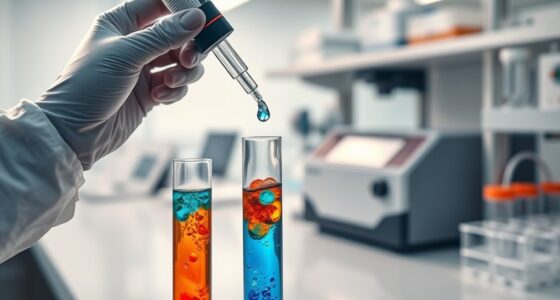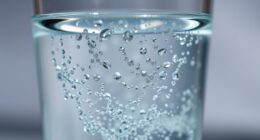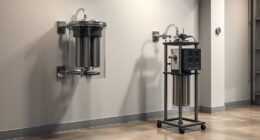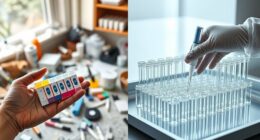If you’re looking for the complete chlorine residual testing maintenance playbook, it offers essential steps to guarantee water safety through proper monitoring. You’ll learn how to select the right testing methods, maintain and calibrate equipment, and collect samples correctly. It also covers establishing schedules, analyzing results, and troubleshooting issues to stay compliant with regulations. Continuing with this guide helps you improve your process and keep water quality at its best.
Key Takeaways
- Establish a routine testing schedule and proper sample collection procedures to ensure accurate chlorine residual measurements.
- Regularly calibrate and maintain testing instruments, including chemical handling and device cleaning, for reliable results.
- Record, organize, and analyze test data with visualization tools to identify trends and operational issues promptly.
- Follow best practices for sample preservation, storage, and contamination prevention to maintain sample integrity.
- Use test results to guide operational adjustments, troubleshoot discrepancies, and ensure compliance with safety standards.
Understanding the Importance of Chlorine Residual Monitoring
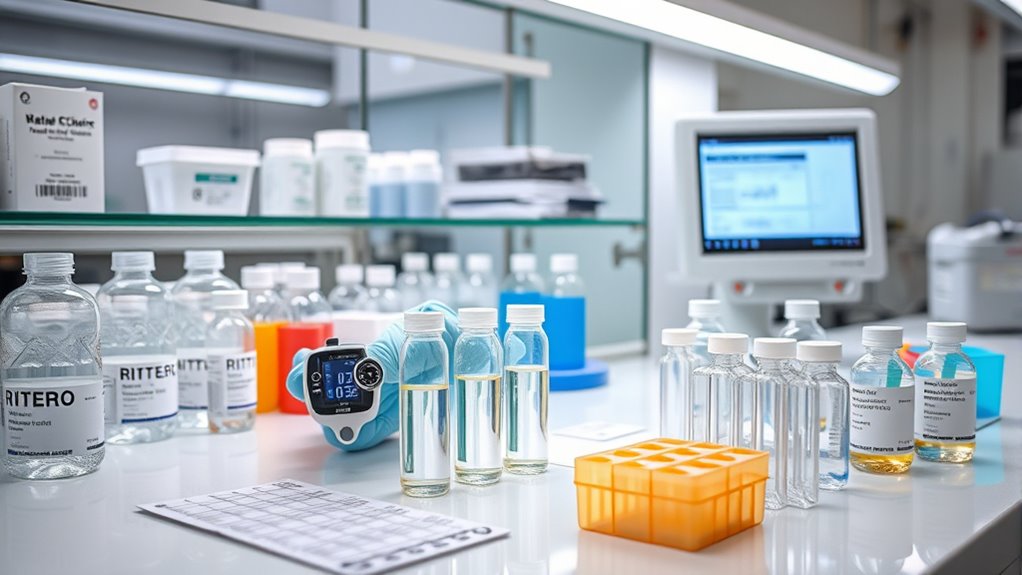
Monitoring chlorine residuals is vital because it directly guarantees that your water remains safe and effective against harmful pathogens. Maintaining proper chlorine stability ensures that disinfectant levels stay within the ideal range, preventing both under- and over-chlorination. When chlorine levels are too low, pathogens can survive and pose health risks, while excessive chlorine can cause taste issues and potential health impacts. Regular residual testing allows you to detect fluctuations early, ensuring consistent disinfection and safeguarding public health. By actively monitoring chlorine residuals, you prevent outbreaks of waterborne illnesses and comply with safety standards. Ultimately, diligent testing supports a reliable, safe water supply, protecting community health and maintaining confidence in your water system. Effective disinfection depends on accurate and consistent testing practices to ensure optimal chlorine levels at all times.
Selecting the Right Testing Methods and Equipment
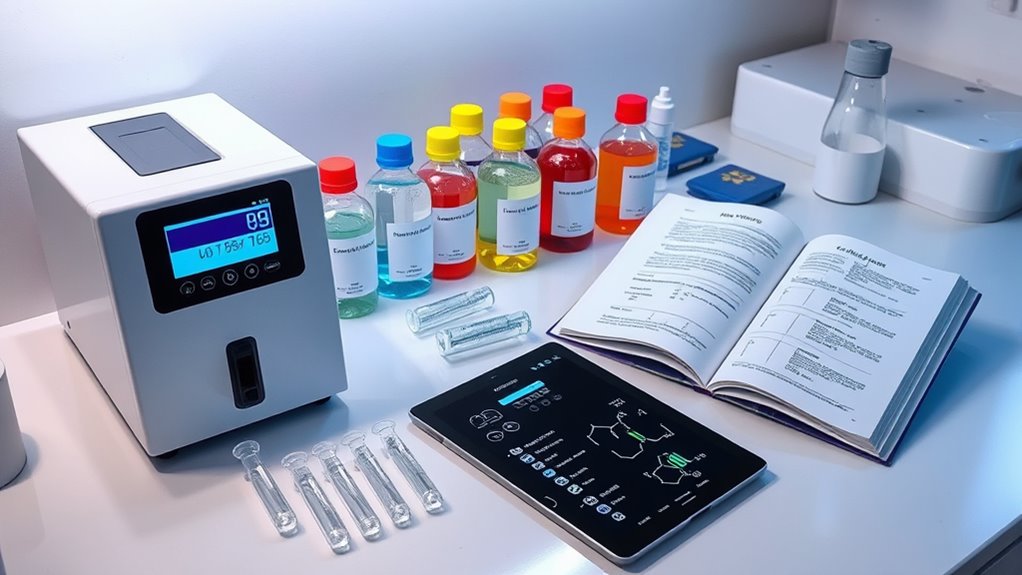
Choosing the appropriate testing methods and equipment is essential to accurately measure chlorine residuals and guarantee effective disinfection. To ensure reliable results, consider these options:
- Use colorimetric methods for quick, cost-effective testing with simple color changes indicating residual levels.
- Opt for digital sensors for continuous, real-time measurements, providing precise data with minimal manual effort.
- Match the method to your facility’s needs—spot testing with colorimetric kits for routine checks or digital sensors for ongoing monitoring.
- Ensure equipment calibration and proper maintenance to maintain accuracy, regardless of the method chosen.
- Regular maintenance and cleaning of testing devices, such as sensors and colorimetric kits, are vital for preserving their accuracy and longevity for optimal performance.
Establishing a Regular Testing Schedule
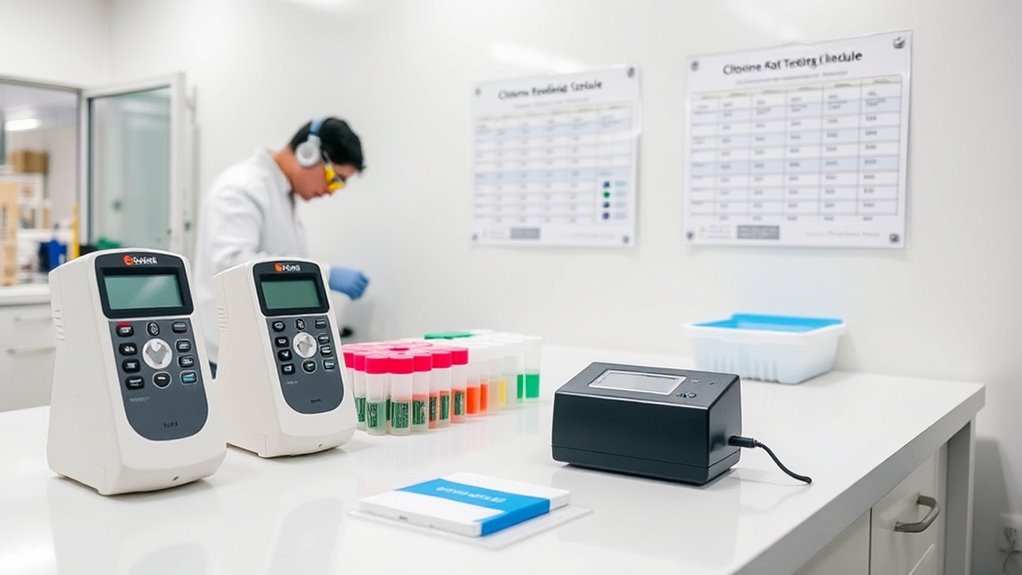
To maintain effective chlorine disinfection, you need to establish a consistent testing schedule that guarantees water quality remains within safe and effective levels. Regular testing helps monitor chemical balance, preventing issues like over or under-chlorination. Consistent scheduling ensures you catch deviations early, maintaining ideal water conditions. Training your staff on testing procedures is essential; well-trained team members perform accurate tests and interpret results correctly. Set specific intervals—daily, weekly, or monthly—based on your system’s size and usage. Document each test, track trends, and adjust your maintenance plan accordingly. This disciplined approach minimizes risks, supports compliance, and guarantees continuous safe water delivery. An established schedule turns routine testing into a critical part of your overall water management strategy. Incorporating digital literacy into your monitoring practices can also streamline data analysis and improve response times.
Proper Sample Collection and Handling Procedures
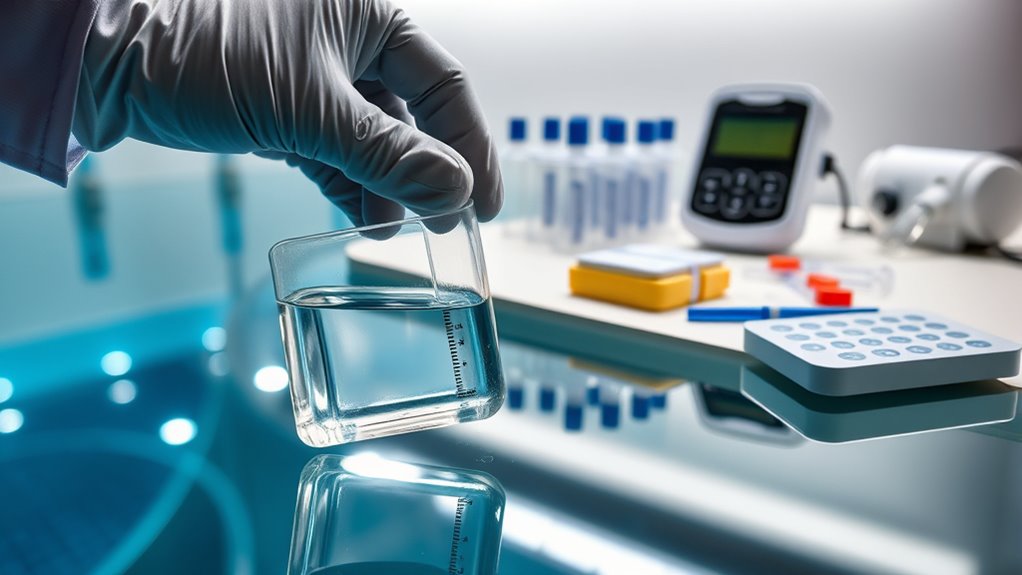
To get accurate chlorine residual test results, you need to follow proper sample collection techniques and handle samples carefully. Make sure you maintain and store samples correctly to prevent changes in chlorine levels, and always take steps to avoid contamination risks. Proper procedures ensure reliable data and effective water treatment. Additionally, understanding field recording techniques can help in documenting sample conditions and environmental factors that may influence test outcomes.
Sample Collection Techniques
Proper sample collection and handling are essential to guarantee accurate chlorine residual testing results. To ensure reliable data, follow these steps:
- Use clean, appropriate collection containers designed for water testing to prevent contamination.
- Fill containers carefully, avoiding air bubbles that can affect sample preservation.
- Label samples clearly with date, time, and location for accurate tracking.
- Minimize exposure to sunlight and extreme temperatures during transport, as this impacts sample preservation.
- Ensure proper sample storage conditions to maintain sample integrity until testing.
Always handle samples gently and keep them chilled if delays occur. Proper collection techniques help maintain sample integrity, guaranteeing accurate residual readings. Remember, using the right collection containers and handling procedures is crucial for valid test results and effective water quality management.
Preservation and Storage Methods
Effective preservation and storage of water samples are essential to maintain their integrity before testing. Use clean, airtight storage containers made of materials like polyethylene or glass to prevent contamination or chemical interactions. Proper storage containers should be tightly sealed to avoid exposure to external elements. Temperature control is critical; samples should be kept at 4°C (39°F) to slow microbial activity and chemical changes. Avoid temperature fluctuations by storing samples in a cooler or refrigerated environment immediately after collection. Keep samples upright and protected from light to prevent degradation. Label containers clearly with collection details and ensure they’re sealed properly. Following these preservation and storage methods ensures your samples remain representative of the original water quality until analysis. Additionally, consulting sampling best practices can help optimize sample integrity throughout the process.
Avoiding Contamination Risks
Ensuring accurate chlorine residual testing begins with meticulous sample collection and handling to prevent contamination. Contaminated samples can lead to inaccurate readings, increasing the risk of disinfection byproducts and public health risks. To avoid this, follow these steps:
- Use sterile, properly labeled containers to prevent introducing foreign substances.
- Rinse bottles with the sample water before collecting to minimize contamination.
- Collect samples midstream and avoid touching the inside of the cap or container.
- Keep samples cool and analyze them promptly to preserve integrity.
- Proper sample storage and handling procedures are essential to maintain sample quality and obtain reliable test results.
Calibration and Maintenance of Testing Instruments
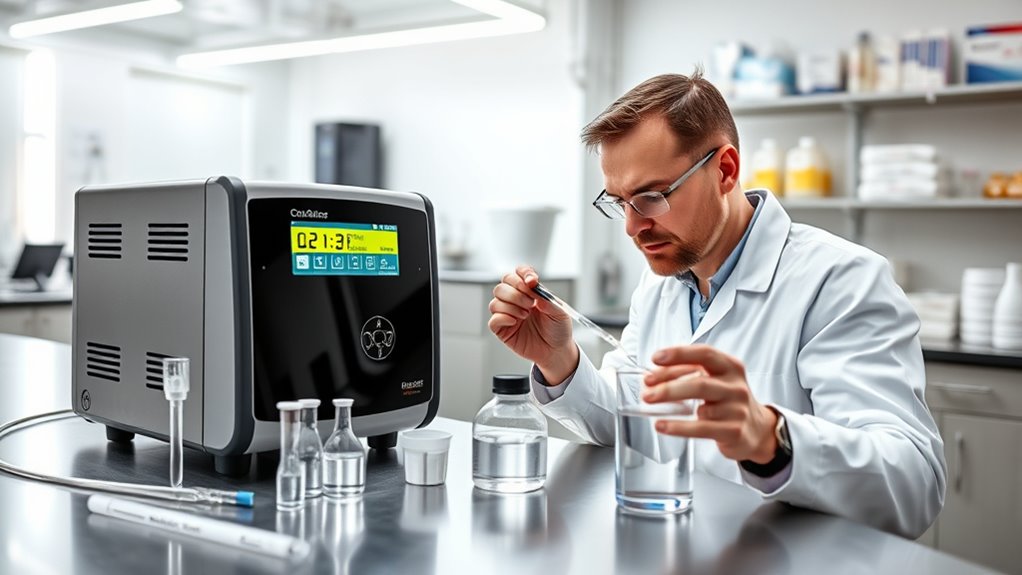
Regular calibration and maintenance of your chlorine residual testing instruments are essential to obtain accurate and reliable results. Proper instrument calibration ensures that your device provides precise measurements, preventing false readings that could compromise water quality. Follow recommended maintenance procedures, such as cleaning sensor probes regularly and inspecting for damage or wear. Keep calibration solutions fresh and stored properly to maintain their accuracy. Document calibration dates and any adjustments made, so you can track instrument performance over time. Regularly check batteries and replace them as needed to avoid unexpected failures. Maintaining your testing instruments with consistent calibration and routine upkeep helps ensure consistent, trustworthy chlorine residual data, supporting effective water treatment and safety standards. Additionally, understanding testing instrument features can help optimize your maintenance routine and improve overall accuracy.
Recording, Analyzing, and Interpreting Test Results
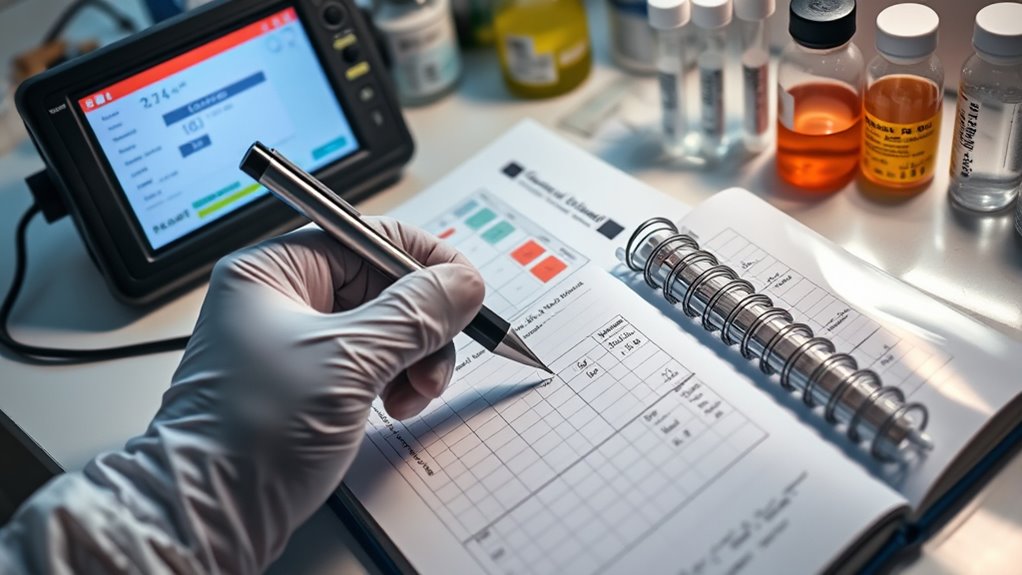
Once your testing instruments are properly calibrated and maintained, the next step is to systematically record your chlorine residual results. Accurate record keeping ensures you can track trends and identify issues early. To analyze your data effectively:
- Organize results chronologically to observe fluctuations over time.
- Use data visualization tools like charts or graphs for quick interpretation.
- Compare current readings with regulatory standards to ensure compliance.
- Look for patterns indicating potential problems or improvements in your system.
- Staying informed about advancements in machine learning technology can help automate data analysis and improve accuracy.
Interpreting test results helps you make informed decisions and maintain water quality. Regular analysis not only highlights anomalies but also guides operational adjustments. Keeping clear, visual records simplifies communication with inspectors and team members, ensuring everyone stays informed and proactive.
Troubleshooting Common Issues and Ensuring Regulatory Compliance

When you encounter discrepancies in your chlorine residual tests or notice readings outside regulatory limits, troubleshooting becomes essential to maintain water quality and compliance. Chemical reactions in your water can cause unexpected test results, so verify that your testing procedures and equipment are accurate and calibrated correctly. Ensure you’re following regulatory standards, which specify acceptable residual levels, and check for factors like pH and temperature that influence chlorine stability. Misreading or inconsistent results may stem from contaminated samples or improper storage. If issues persist, review your sampling methods and reagent quality. Staying compliant requires understanding these chemical interactions and promptly addressing any anomalies. Regularly reviewing test procedures and maintaining equipment helps prevent issues, ensuring your water consistently meets regulatory requirements. Additionally, understanding the Glycolic Acid Benefits for Skin can inform proper handling and storage of chemicals, preventing contamination and ensuring accurate test outcomes.
Frequently Asked Questions
How Often Should Chlorine Residual Tests Be Updated for Changing Water Conditions?
You should update your testing frequency based on water variability, ideally testing more often during periods of rapid change, such as after heavy rainfall or temperature shifts. Regular testing guarantees you accurately monitor chlorine residuals and maintain water quality. When water conditions are stable, testing can be less frequent, but always stay alert to signs of variability that require increased testing to ensure safe, consistent chlorination levels.
What Are Common Signs of Inaccurate Chlorine Residual Readings?
You’ll notice inaccurate chlorine residual readings if your testing calibration isn’t correct or if sample contamination occurs. Common signs include unexpected fluctuations in chlorine levels, inconsistent results between tests, or readings that don’t match your water’s taste and smell. Always double-check your calibration, verify samples are uncontaminated, and follow proper testing procedures to get accurate, reliable results. Regular maintenance helps prevent these issues and ensures water safety.
Are There Specific Safety Precautions During Sample Collection?
You should always wear personal protective equipment, like gloves and goggles, during sample collection to stay safe from chlorine exposure. Follow strict sample handling procedures to prevent contamination and guarantee accurate results. Be cautious when opening sample containers, and avoid spills. Properly label and store samples, and wash your hands afterward. These safety precautions protect you and help maintain the integrity of your testing process.
How Can Automation Improve Chlorine Residual Testing Accuracy?
Automation acts like a vigilant eye, catching errors before they drift into inaccuracies. By integrating sensors and automating processes, you guarantee precise readings every time. Regular sensor calibration keeps this eye sharp, preventing drift and maintaining trust in your data. This seamless dance of automation reduces human error, speeds up testing, and sharpens accuracy—transforming chlorine residual testing from guesswork into a reliable, high-precision routine that keeps your water safe and your confidence high.
What Training Is Recommended for Staff Performing Residual Testing?
You should guarantee your staff receives proper certification in residual testing to guarantee accurate results. Training should cover testing protocols thoroughly, including sample collection, reagent handling, and device calibration. Regular refresher courses help maintain skill levels and stay updated on best practices. By investing in staff certification and emphasizing testing protocols, you improve testing accuracy and ensure consistent water quality, ultimately safeguarding public health and compliance standards.
Conclusion
By understanding the importance of monitoring, selecting the right methods, establishing a routine, handling samples properly, maintaining your equipment, and analyzing results accurately, you guarantee safe water quality. Consistent testing, diligent calibration, and thorough documentation help you troubleshoot issues and stay compliant. With these practices in place, you uphold your responsibilities, protect public health, and maintain confidence in your water system—because diligent maintenance isn’t just a task, it’s a commitment to excellence.



